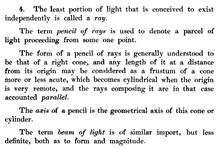

In optics, a pencil or pencil of rays is a geometric construct used to describe a beam or portion of a beam of electromagnetic radiation or charged particles, typically in the form of a narrow beam (conical or cylindrical).
Antennas which strongly bundle in azimuth and elevation are often described as "pencil-beam" antennas. For example, a phased array antenna can send out a beam that is extremely thin. Such antennas are used for tracking radar, and the process is known as beamforming.
In optics, the focusing action of a lens is often described in terms of pencils of rays. In addition to conical and cylindrical pencils, optics deals with astigmatic pencils as well.
In electron optics, scanning electron microscopes use narrow pencil beams to achieve a deep depth of field.
Ionizing radiation used in radiation therapy, whether photons or charged particles, such as proton therapy and electron therapy machines, is sometimes delivered through the use of pencil beam scanning.
In backscatter X-ray imaging a pencil beam of x-ray radiation is used to scan over an object to create an intensity image of the Compton-scattered radiation.
History


A 1675 work describes a pencil as "a double cone of rays, joined together at the base." In his 1829 A System of Optics, Henry Coddington defines a pencil as being "a parcel of light proceeding from some one point", whose form is "generally understood to be that of a right cone" and which "becomes cylindrical when the origin is very remote".
See also
- Collimated beam
- Pencil (mathematics), a family of geometric objects having a common property such as passage through a given point.
- Fan beam
- Pencil beam scanning (Medical physics)
- Microwave transmission
References
- Edward L. Nichols & William S. Franklin (1903). The Elements of Physics: A College Text-book. Macmillan Co. p. 77.
- Nick Johnson (19 May 1983). "The art of seeing the very small". New Scientist. 98 (1358): 472.
- Faiz M. Khan (2009). The Physics of Radiation Therapy (4th ed.). Lippincott Williams & Wilkins. pp. 521–522. ISBN 978-0-7817-8856-4.
- Bailey, Nathan (1675). "An Universal Etymological English Dictionary". Retrieved 24 November 2022.
- Coddington, Henry (1829). A System of Optics: A treatise on the reflexion and refraction of light. -pt.2 A treatise on the eye and on optical instruments. J. Smith. Retrieved 24 November 2022.
This optics-related article is a stub. You can help Misplaced Pages by expanding it. |